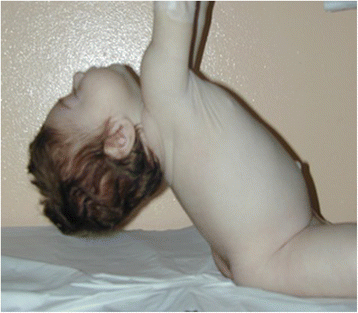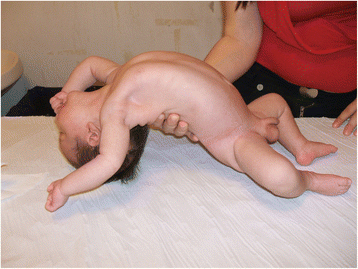Congenital muscular dystrophy: from muscle to brain
- PMID: 27576556
- PMCID: PMC5006267
- DOI: 10.1186/s13052-016-0289-9
Congenital muscular dystrophy: from muscle to brain
Abstract
Congenital muscular dystrophies (CMDs) are a wide group of muscular disorders that manifest with very early onset of muscular weakness, sometime associated to severe brain involvement.The histologic pattern of muscle anomalies is typical of dystrophic lesions but quite variable depending on the different stages and on the severity of the disorder.Recent classification of CMDs have been reported most of which based on the combination of clinical, biochemical, molecular and genetic findings, but genotype/phenotype correlation are in constant progression due to more diffuse utilization of the molecular analysis.In this article, the Authors report on CMDs belonging to the group of dystroglycanopathies and in particular on the most severe forms represented by the Fukuyama CMD, Muscle-Eye-Brain disease and Walker Walburg syndrome.Clinical diagnosis of infantile hypotonia is particularly difficult considering the different etiologic factors causing the lesions, the difficulty in localizing the involved CNS area (central vs. peripheral) and the limited role of the diagnostic procedures at this early age.The diagnostic evaluation is not easy mainly in differentiating the various types of CMDs, and represents a challenge for the neonatologists and pediatricians. Suggestions are reported on the way to reach a correct diagnosis with the appropriate use of the diagnostic means.
Keywords: Brain involvement; Congenital muscle diseases; Fukuyama congenital muscular dystrophy; Muscle-eye-brain disease; Muscular dystrophies; Walker-Warburg syndrome.
Figures









Similar articles
-
Congenital muscular dystrophy. Part I: a review of phenotypical and diagnostic aspects.Arq Neuropsiquiatr. 2009 Mar;67(1):144-68. doi: 10.1590/s0004-282x2009000100038. Arq Neuropsiquiatr. 2009. PMID: 19330236 Review.
-
Congenital muscular dystrophy. Part II: a review of pathogenesis and therapeutic perspectives.Arq Neuropsiquiatr. 2009 Jun;67(2A):343-62. doi: 10.1590/s0004-282x2009000200035. Arq Neuropsiquiatr. 2009. PMID: 19547838 Review.
-
Neuroimaging manifestations and classification of congenital muscular dystrophies.AJNR Am J Neuroradiol. 1998 Sep;19(8):1389-96. AJNR Am J Neuroradiol. 1998. PMID: 9763366 Free PMC article.
-
Expression profiling of muscles from Fukuyama-type congenital muscular dystrophy and laminin-alpha 2 deficient congenital muscular dystrophy; is congenital muscular dystrophy a primary fibrotic disease?Biochem Biophys Res Commun. 2006 Apr 7;342(2):489-502. doi: 10.1016/j.bbrc.2005.12.224. Epub 2006 Feb 3. Biochem Biophys Res Commun. 2006. PMID: 16487936
-
Congenital muscular dystrophies: 1997 update.Brain Dev. 1998 Mar;20(2):65-74. doi: 10.1016/s0387-7604(97)00094-6. Brain Dev. 1998. PMID: 9545174 Review.
Cited by
-
Recent advancements in understanding mammalian O-mannosylation.Glycobiology. 2017 Sep 1;27(9):806-819. doi: 10.1093/glycob/cwx062. Glycobiology. 2017. PMID: 28810660 Free PMC article. Review.
-
Advances in imaging of brain abnormalities in neuromuscular disease.Ther Adv Neurol Disord. 2019 May 6;12:1756286419845567. doi: 10.1177/1756286419845567. eCollection 2019. Ther Adv Neurol Disord. 2019. PMID: 31105770 Free PMC article. Review.
-
Agrin-Mediated Cardiac Regeneration: Some Open Questions.Front Bioeng Biotechnol. 2020 Jun 16;8:594. doi: 10.3389/fbioe.2020.00594. eCollection 2020. Front Bioeng Biotechnol. 2020. PMID: 32612983 Free PMC article.
-
Compound heterozygous POMGNT1 mutations leading to muscular dystrophy-dystroglycanopathy type A3: a case report.BMC Pediatr. 2019 Apr 8;19(1):98. doi: 10.1186/s12887-019-1470-2. BMC Pediatr. 2019. PMID: 30961548 Free PMC article.
-
Peripheral nervous system manifestations of Shiga toxin-producing E. coli-induced haemolytic uremic syndrome in children.Ital J Pediatr. 2021 Sep 6;47(1):181. doi: 10.1186/s13052-021-01133-1. Ital J Pediatr. 2021. PMID: 34488831 Free PMC article.
References
-
- Bönnemann CG, Wang CH, Quijano-Roy S, Deconinck N, Bertini E, Ferreiro A, Members of International Standard of Care Committee for Congenital Muscular Dystrophies et al. Diagnostic approach to the congenital muscular dystrophies. Neuromuscul Disord. 2014;24:289–311. doi: 10.1016/j.nmd.2013.12.011. - DOI - PMC - PubMed
Publication types
MeSH terms
LinkOut - more resources
Full Text Sources
Other Literature Sources
Medical

